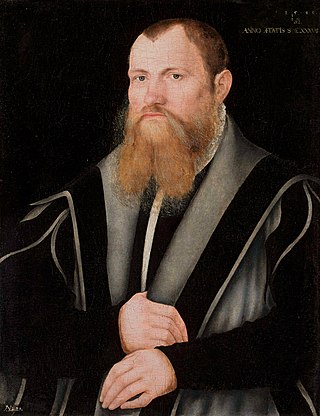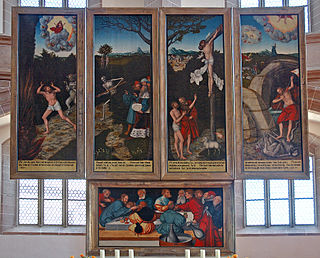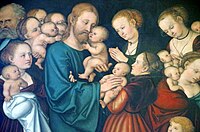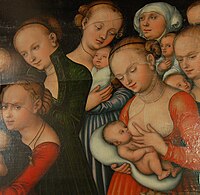
A crucifix is a cross with an image of Jesus on it, as distinct from a bare cross. The representation of Jesus himself on the cross is referred to in English as the corpus.

Lucas Cranach the Younger was a German Renaissance painter and portraitist, the son of Lucas Cranach the Elder and brother of Hans Cranach.

Lucas Cranach the Elder was a German Renaissance painter and printmaker in woodcut and engraving. He was court painter to the Electors of Saxony for most of his career, and is known for his portraits, both of German princes and those of the leaders of the Protestant Reformation, whose cause he embraced with enthusiasm. He was a close friend of Martin Luther. Cranach also painted religious subjects, first in the Catholic tradition, and later trying to find new ways of conveying Lutheran religious concerns in art. He continued throughout his career to paint nude subjects drawn from mythology and religion.

Christian art is sacred art which uses subjects, themes, and imagery from Christianity. Most Christian groups use or have used art to some extent, including early Christian art and architecture and Christian media.

The Protestant Reformation during the 16th century in Europe almost entirely rejected the existing tradition of Catholic art, and very often destroyed as much of it as it could reach. A new artistic tradition developed, producing far smaller quantities of art that followed Protestant agendas and diverged drastically from the southern European tradition and the humanist art produced during the High Renaissance. The Lutheran churches, as they developed, accepted a limited role for larger works of art in churches, and also encouraged prints and book illustrations. Calvinists remained steadfastly opposed to art in churches, and suspicious of small printed images of religious subjects, though generally fully accepting secular images in their homes.
Master IW, also Monogramist I.W., was a Bohemian or Saxon Renaissance painter, trained in the workshop of Lucas Cranach the Elder, active between 1520 and 1550 mainly in north-west Bohemia.

Christ taking leave of his Mother is a subject in Christian art, most commonly found in Northern art of the 15th and 16th centuries. Christ says farewell to his mother Mary, often blessing her, before leaving for his final journey to Jerusalem, which he knows will lead to his Passion and death; indeed this scene marks the beginning of his Passion. In early versions just these two figures are usually shown, at half-length or less.

The Last Supper of Jesus and the Twelve Apostles has been a popular subject in Christian art, often as part of a cycle showing the Life of Christ. Depictions of the Last Supper in Christian art date back to early Christianity and can be seen in the Catacombs of Rome.

After Luther's objections to large public religious images had started to fade, Lucas Cranach the Elder, along with his son and workshop began to work on a number of altarpieces of the Last Supper, among other subjects.

The Stadt- und Pfarrkirche St. Marien zu Wittenberg is the civic church of the German town of Lutherstadt Wittenberg. The reformers Martin Luther and Johannes Bugenhagen preached there and the building also saw the first celebration of the mass in German rather than Latin and the first ever distribution of the bread and wine to the congregation – it is thus considered the mother-church of the Protestant Reformation. In 1996, it was inscribed on the UNESCO World Heritage List along with Castle Church of All Saints (Schlosskirche), the Lutherhaus, the Melanchthonhaus, and Martin Luther's birth house and death house in Eisleben, because of its religious significance and testimony to the lasting, global influence of Protestantism.

Crucifixion is an oil painting by German artist Lucas Cranach the Elder. One of many versions of the subject painted by Cranach, this one, created in 1532, is now in the Indianapolis Museum of Art.

Law and Gospel is one of a number of thematically linked, allegorical panel paintings by Lucas Cranach the Elder from about 1529. The paintings, intended to illustrate Lutheran ideas of salvation, are exemplars of Lutheran Merkbilder, which were simple, didactic illustrations of Christian doctrine.

Cupid complaining to Venus is an oil painting by Lucas Cranach the Elder. Nearly 20 similar works by Cranach and his workshop are known, from the earliest dated version in Güstrow Palace of 1527 to one in the Burrell Collection, Glasgow, dated to 1545, with the figures in a variety of poses and differing in other details. The Metropolitan Museum of Art notes that the number of extant versions suggests that this was one of Cranach's most successful compositions.

Law and Grace is considered one of the most important paintings by Lucas Cranach the Elder. This work, in the collection of the National Gallery in Prague, is one of the two oldest known versions of this theme and was executed in 1529. It is also called the Prague type and provided the model for a series of other paintings including an early-16th-century copy that is also kept in the Prague National Gallery's collection of Old European art. It is the best-known and most influential allegory depicting the fundamental tenets of Luther's reform of the church.

Caritas is an oil on panel painting by German painter Lucas Cranach the Elder. The painting is kept in the Royal Museum of Fine Arts, Antwerp.
The Votive Painting from Šopka (1530) is the work of an anonymous disciple of Lucas Cranach the Elder, who worked in north-west Bohemia and is referred to by the initials with which he signed his paintings as Master IW. The painting was discovered at the end of the 19th century in the parish church, formerly the Augustinian Monastery Church of St. Laurence in Šopka and is exhibited in the Gallery and Museum of the Litoměřice Diocese.

Lamentation over the Dead Body of Christ is an oil painting on wood panel completed by a follower of the German Renaissance artist Lucas Cranach the Elder during the 1530s. It is considered to be among the most valued works of art to have been plundered from Polish collections during World War II.

The Schneeberg Altarpiece is a Lutheran winged altarpiece created in 1539 by Lucas Cranach the Elder for the Church of St. Wolfgang in Schneeberg in Saxony, Germany. The altarpiece was commissioned in 1531–1532 by the Elector of Saxony John I of Saxony and installed in the church in 1539, making it the first Protestant altarpiece of Reformation which is considered a Saxon masterpiece of art.

Weimar Cranach Altarpiece is a Lutheran winged altarpiece created by Lucas Cranach the Elder and his son Lucas Cranach the Younger between 1552 and 1555 for the Church of St. Peter und Paul in Weimar, Germany.

Wittenberg Cranach Altarpiece is one of the major Lutheran winged altarpieces created by Lucas Cranach the Elder and his son Lucas Cranach the Younger for the Evangelical Lutheran City and Parish Church of St. Mary's in Wittenberg, Germany. The altarpiece depicts the key figures of Lutheranism associated with the parish church of Wittenberg.
























